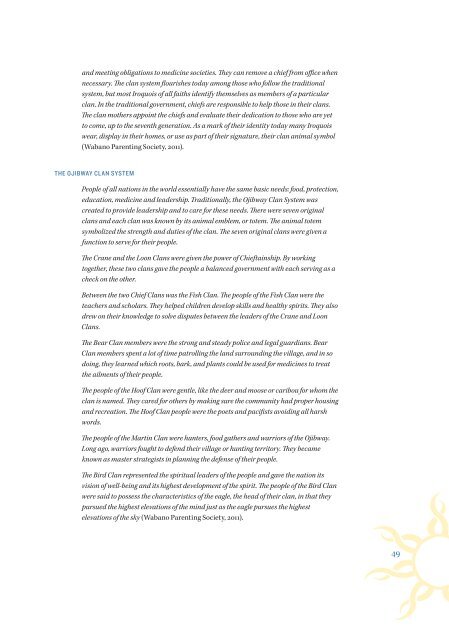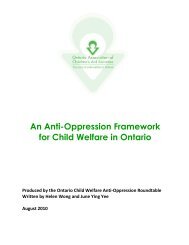English - Ontario Association of Children's Aid Societies
English - Ontario Association of Children's Aid Societies
English - Ontario Association of Children's Aid Societies
You also want an ePaper? Increase the reach of your titles
YUMPU automatically turns print PDFs into web optimized ePapers that Google loves.
and meeting obligations to medicine societies. They can remove a chief from <strong>of</strong>fice when<br />
necessary. The clan system flourishes today among those who follow the traditional<br />
system, but most Iroquois <strong>of</strong> all faiths identify themselves as members <strong>of</strong> a particular<br />
clan. In the traditional government, chiefs are responsible to help those in their clans.<br />
The clan mothers appoint the chiefs and evaluate their dedication to those who are yet<br />
to come, up to the seventh generation. As a mark <strong>of</strong> their identity today many Iroquois<br />
wear, display in their homes, or use as part <strong>of</strong> their signature, their clan animal symbol<br />
(Wabano Parenting Society, 2011).<br />
THE OJIBWAY CLAN SYSTEM<br />
People <strong>of</strong> all nations in the world essentially have the same basic needs: food, protection,<br />
education, medicine and leadership. Traditionally, the Ojibway Clan System was<br />
created to provide leadership and to care for these needs. There were seven original<br />
clans and each clan was known by its animal emblem, or totem. The animal totem<br />
symbolized the strength and duties <strong>of</strong> the clan. The seven original clans were given a<br />
function to serve for their people.<br />
The Crane and the Loon Clans were given the power <strong>of</strong> Chieftainship. By working<br />
together, these two clans gave the people a balanced government with each serving as a<br />
check on the other.<br />
Between the two Chief Clans was the Fish Clan. The people <strong>of</strong> the Fish Clan were the<br />
teachers and scholars. They helped children develop skills and healthy spirits. They also<br />
drew on their knowledge to solve disputes between the leaders <strong>of</strong> the Crane and Loon<br />
Clans.<br />
The Bear Clan members were the strong and steady police and legal guardians. Bear<br />
Clan members spent a lot <strong>of</strong> time patrolling the land surrounding the village, and in so<br />
doing, they learned which roots, bark, and plants could be used for medicines to treat<br />
the ailments <strong>of</strong> their people.<br />
The people <strong>of</strong> the Ho<strong>of</strong> Clan were gentle, like the deer and moose or caribou for whom the<br />
clan is named. They cared for others by making sure the community had proper housing<br />
and recreation. The Ho<strong>of</strong> Clan people were the poets and pacifists avoiding all harsh<br />
words.<br />
The people <strong>of</strong> the Martin Clan were hunters, food gathers and warriors <strong>of</strong> the Ojibway.<br />
Long ago, warriors fought to defend their village or hunting territory. They became<br />
known as master strategists in planning the defense <strong>of</strong> their people.<br />
The Bird Clan represented the spiritual leaders <strong>of</strong> the people and gave the nation its<br />
vision <strong>of</strong> well-being and its highest development <strong>of</strong> the spirit. The people <strong>of</strong> the Bird Clan<br />
were said to possess the characteristics <strong>of</strong> the eagle, the head <strong>of</strong> their clan, in that they<br />
pursued the highest elevations <strong>of</strong> the mind just as the eagle pursues the highest<br />
elevations <strong>of</strong> the sky (Wabano Parenting Society, 2011).<br />
49

















